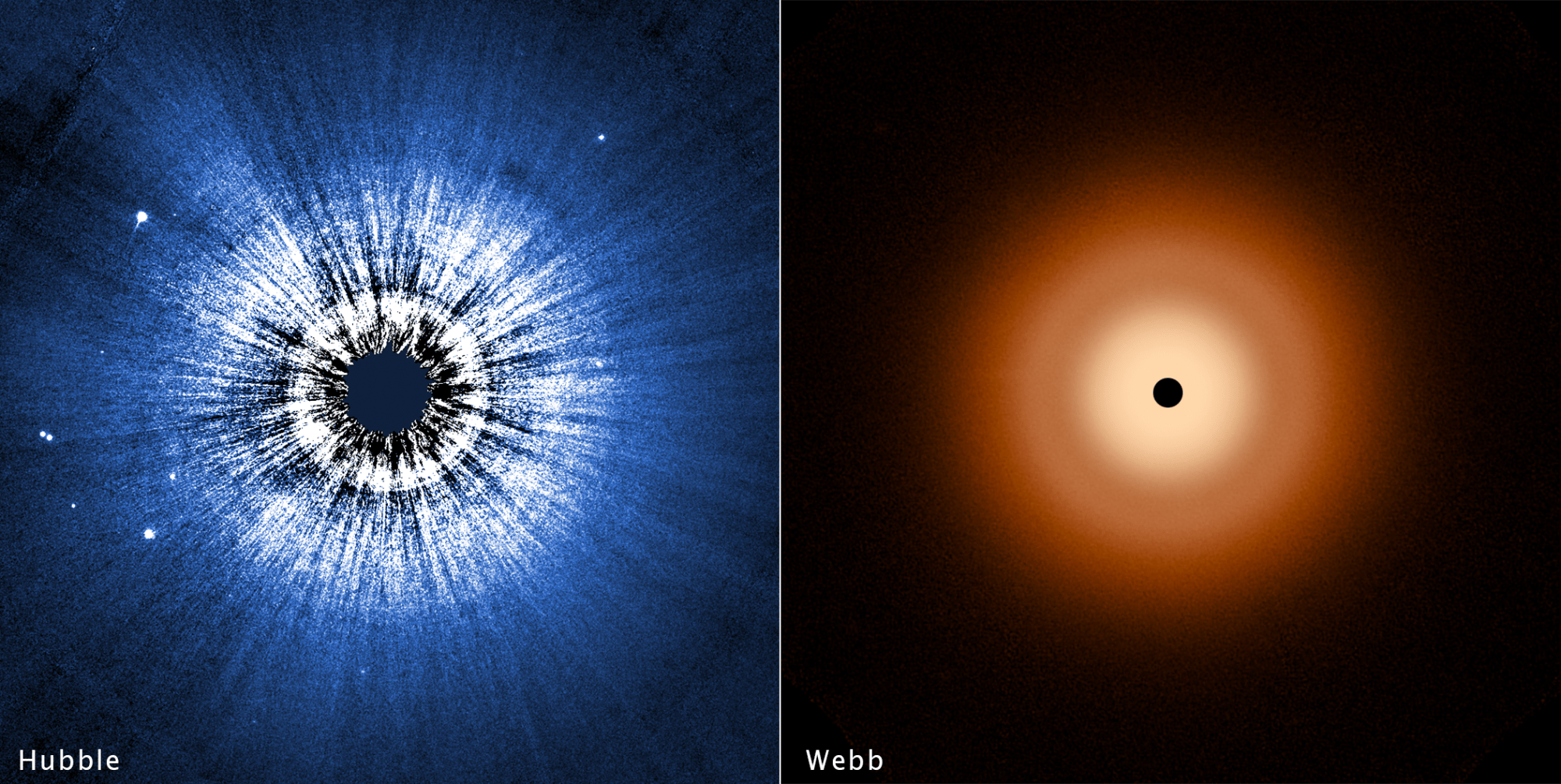1 min read
Hubble and Webb Observations of Vega Circumstellar Disk

[left]
A Hubble Space Telescope false-color view of a 100-billion-mile-wide disk of dust around the summer star Vega. Hubble detects reflected light from dust that is the size of smoke particles largely in a halo on the periphery of the disk. The disk is very smooth, with no evidence of embedded large planets. The black spot at the center blocks out the bright glow of the hot young star.
[right]
The James Webb Space Telescope resolves the glow of warm dust in a disk halo, at 23 billion miles out. The outer disk (analogous to the solar system's Kuiper Belt) extends from 7 billion miles to 15 billion miles. The inner disk extends from the inner edge of the outer disk down to close proximity to the star. There is a notable dip in surface brightness of the inner disk from approximately 3.7 to 7.2 billion miles. The black spot at the center is due to lack of data from saturation.
About the Object
- R.A. PositionR.A. PositionRight ascension – analogous to longitude – is one component of an object's position.18:36:56.34
- Dec. PositionDec. PositionDeclination – analogous to latitude – is one component of an object's position.+38:47:01.28
- ConstellationConstellationOne of 88 recognized regions of the celestial sphere in which the object appears.Lyra
- DistanceDistanceThe physical distance from Earth to the astronomical object. Distances within our solar system are usually measured in Astronomical Units (AU). Distances between stars are usually measured in light-years. Interstellar distances can also be measured in parsecs.25 light-years
About the Data
- Data DescriptionData DescriptionProposal: A description of the observations, their scientific justification, and the links to the data available in the science archive.
Science Team: The astronomers who planned the observations and analyzed the data. "PI" refers to the Principal Investigator. - InstrumentInstrumentThe science instrument used to produce the data.Hubble: STIS; Webb: MIRI
- Exposure DatesExposure DatesThe date(s) that the telescope made its observations and the total exposure time.Hubble: April 2022 - February 2023; Webb: August 2023
- FiltersFiltersThe camera filters that were used in the science observations.Hubble: STIS 50CORON; Webb: MIRI F2550W
- Object NameObject NameA name or catalog number that astronomers use to identify an astronomical object.Vega
- Object DescriptionObject DescriptionThe type of astronomical object.Dusty debris disk
- Release DateNovember 1, 2024
- Science ReleaseNASA’s Hubble, Webb Probe Surprisingly Smooth Disk Around Vega
- CreditNASA, ESA, CSA, STScI, S. Wolff (University of Arizona), K. Su (University of Arizona), A. Gáspár (University of Arizona)
Downloads

These images were acquired by the STIS instrument on the Hubble and MIRI instrument on Webb. The color results from assigning a hue to a monochromatic (grayscale) image, blue for Hubble and orange for Webb.

Related Images & Videos

Vega Hubble Compass Image
A Hubble Space Telescope false-color view of a 100-billion-mile-wide disk of dust around the summer star Vega. Hubble detects reflected light from dust that is the size of smoke particles largely in a halo on the periphery of the disk. The disk is very smooth, with no evidence...

Vega Webb Compass Image
This is a James Webb Space Telescope view of a 100-billion-mile-wide disk of dust around the star Vega. The disk is remarkably smooth and there is no debatable evidence for planet formation taking place. Webb resolves the glow of warm dust in a disk halo, at 23 billion miles...
Share
Details
Claire Andreoli
NASA’s Goddard Space Flight Center
Greenbelt, Maryland
claire.andreoli@nasa.gov




























